Tips From Sticks-In-The-Mud Woodshop
by Jim Randolph
Long Beach, Mississippi
Click on any picture to see a larger version.
Welcome to "Tips From Sticks-In-The-Mud Woodshop". I am a hobbyist, not a professional, someone who loves woodworking, just like you do. I have found some better ways to accomplish tasks in the workshop and look forward to sharing those with you each month, as well as hearing your problem-solving ideas.
Tip #1
Nothing kills the back like bending over. Conversely, nothing kills the shoulders like a work surface that's too high for the user. I'm tall, so I built my main workbench 39 1/2" inches high.
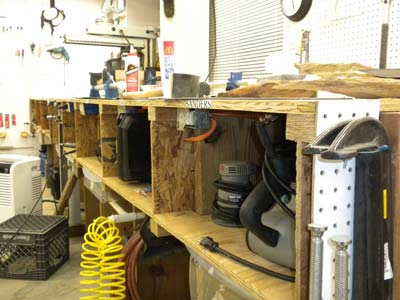
|
|
The floors in our home are framed with McMillan TrusJoists. It was my first introduction to them. We had lots of scraps. Because one joist can span over 20 feet with no deflection under its own weight, I used one to form the perfectly-straight back (wall) support for my radial arm saw/work table. Joist hangers made it easy to put perpendiculars anywhere I wanted, making support for the front of the table and compartments for storage.
|
I raised my DeWalt 13" planer with some 4x6 treated pine plus a scrap of 3/4" CDX plywood I had sitting around.
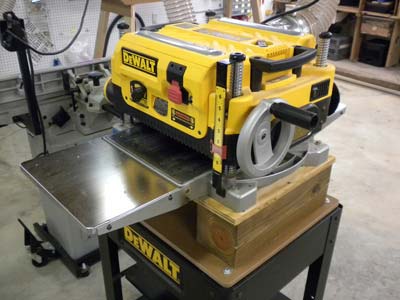
|
All the back and forth one does when planing is made a little easier by not having to stoop
to start the infed piece or catch the outfed piece.
|
When I used Norm Abram's plans to build my portable power miter box stand, the spruce studs I cut in half to make the legs put the working height several inches higher than the plans, but just right for me.
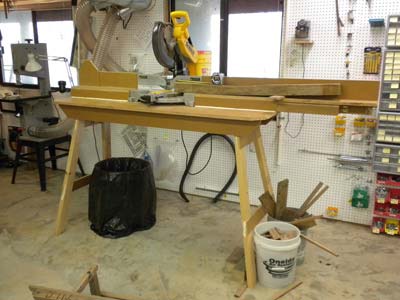
|
Many would find this setup uncomfortably high, but, for me it's just right, and a backsaver.
Note the zipper-locking bag storage lower left.
|
I never have to bend over to view a measurement before a cut.
Sanding is something I like to do outside, just to keep from filling the entire garage with dust. We keep a picnic table on the deck just outside the shop door. I made it at a comfortable height for eating, compromising for all sizes of people. To transform it into the perfect sanding station I made this little box from plywood scraps.
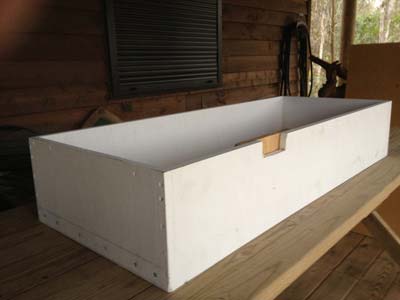
|
|
Made from scraps of 3/4" CDX plywood, this box reduces back muscle strain while sanding by lifting the work up.
|
I have a scrap of MDF that fits perfectly on top for a flat, stable surface. It has an assigned hanging place on the wall, out of the way when not in use. I used it that way for years, and just recently got the idea for adding the (scrap) pegboard to make a downdraft table. (I'll let you know how that works out, as I don't yet have the hardware for a dust collector connection.)
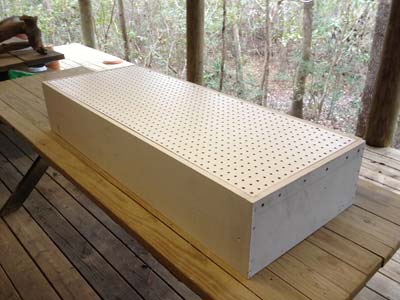
|
|
Some strips of 3/4" plywood inside as a ledge for the pegboard top, then screw it down, being careful to get screw heads recessed so that they don't scratch the work.
|
The pegboard is set flush, so I can still set the MDF piece on top if I need a more robust platform. The main point is, if you are having to bend over to perform any task in your workshop, there is a cheap alternative to Advil and chiropractors. Likewise, if you are vertically challenged and suffer arm and shoulder fatigue from working on a too-high table, cut the legs off or make a stool to stand on (also easily made from scraps).

|
|
I made this box to help my wife get into our bed after she broke a leg. The little cutouts on the ends make for easy pickup.
|
Tip #2
No zipper-locking bag ever achieves escape velocity from my garage. In the purse-string bag shown I keep bags of all sizes.
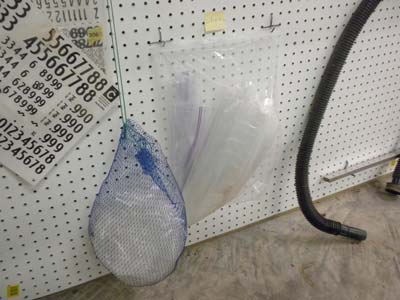
|
All kinds of products come shipped in zipper-locking bags.
You rarely need to purchase any if you simply keep all the ones life sends you.
|
If I need to bag up really tiny parts, I have the bag handy. If I need gallon-size for 9" x 11" sandpaper, I have the bag handy. In the Katrina aftermath we got some really gigantic zipper-locking bags, which I have bagged separately (right-hand side of the photo). All of these hang in an out-of-the-way area of the garage, but are easily accessed when the need arises.
Jim Randolph is a veterinarian in Long Beach, Mississippi. His earlier careers as lawn mower, dairy farmer, automobile mechanic, microwave communications electronics instructor and journeyman carpenter all influence his approach to woodworking. His favorite projects are furniture built for his wife, Brenda, and for their children and grandchildren. His and Brenda's home, nicknamed Sticks-In-The-Mud, is built on pilings (sticks) near the wetlands (mud) on a bayou off Jourdan River. His shop is in the lower level of their home. Questions and comments on woodworking may be sent to
DrRandolph@MyPetsDoctor.com
. Questions about pet care should be directed to his blog on pet care,
www.MyPetsDoctor.com
. We regret that, because of high volume, not all inquiries can be answered personally.
Return to
Wood News
front page


